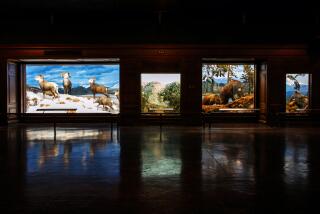Believe it or not, science evolves too
- Share via
Evolutionists rightly complain that creationists ignore or misrepresent the fossil record when they claim that life was created in its present form a few thousand years ago. Fossils provide a tremendous weight of evidence in favor of Charles Darwin’s idea that life -- and the species -- change through billions of years. But creationist tracts are not the only places where the public gets an inadequate view of the evidence. The Smithsonian Institution’s National Museum of Natural History is another -- surprising -- example.
In 1985, I was enthralled by an exhibit I saw at the Washington museum. It was about the Burgess Shale, a spectacular fossil deposit from the Cambrian period, about 500 million years ago, when multicellular life was relatively new. Fascinating ideas about these fossils were emerging. Paleontologists thought the creatures they represented belonged to long-extinct, and hitherto unknown, oddball categories of animals.
To award-winning author and paleontologist Stephen Jay Gould, this suggested that the traditional idea that life began with little diversity and slowly branched out might be wrong. Instead, there could have been an evolutionary “big bang,” in which life exploded all at once into myriad types, only to be reduced subsequently by mass extinctions.
It was an exciting idea, and the Burgess Shale exhibit reflected it, with sparkling new dioramas of bizarre creatures, supposedly lost forever -- a headless caterpillar-like animal, for instance, covered in tubes and spikes and named Hallucigenia.
But exciting new ideas aren’t always right, and later studies have shown that the Burgess oddballs weren’t so odd after all. Hallucigenia, for example, is probably an onychophoran, related to creatures called “velvet worms” common in the tropics today. It seems that the traditional idea that biodiversity has increased through time still has merit.
So I was disturbed when visiting the museum this year to find that the Burgess Shale exhibit presents the same “oddball” message it did in 1985. And it’s not the only outdated information in the museum. Another exhibit informs visitors that fish crawled onto land with their fins and only later evolved legs, although recent fossil discoveries show that fish evolved legs while still living in the water. In other words, the nation’s flagship natural history museum has it wrong.
The museum paleontologists confirmed that schoolkids and tourists who throng the museum are getting caught in a scientific time warp. They say congressional funding for their subject dried up after the early 1980s. That was also about the time when political hostility toward science in general, and evolution in particular, began increasing.
But it hasn’t helped that science and its practitioners seem to be changing, perhaps in response to that hostility, in ways that only enlarge the gap between new discoveries and the public’s knowledge.
When I began interviewing scientists in the early 1970s, most were eager to reach out with their ideas. At the height of the environmental movement, there was a belief that biological knowledge could help society face the problems of pollution, overpopulation and resource depletion that were taken seriously then. Since 1980, however, I’ve encountered growing indifference to “popularization” in professional circles. At a science society’s annual meeting not long ago, the postgraduates I talked to were clearly interested in how to get their names in the paper, but they weren’t very interested in how to communicate science itself to a general audience.
Such a retreat goes against a venerable tradition, particularly among evolutionary scientists. Early Darwinians, such as T.H. Huxley, practiced popularization enthusiastically and saw scientific and social progress as interchangeable. Scientist/authors like Gould and the Pulitzer Prize-winning biologist E.O. Wilson have continued the tradition.
As the ranks of such proselytizers dwindle, their opponents aren’t making the same mistake. Two leading promoters of the “intelligent design” movement, currently the rage among creationists, are prolific writers of popular books and articles. Those two scientists are a biochemist and a mathematician, so they are not as well versed in natural history as a Gould or a Wilson, but that doesn’t stop them from trying to topple Darwin.
Of course they have every right to try. And, when an institution like the National Museum of Natural History is condemned to offer up less-than-accurate and outdated ideas on the same subject, no one should be too surprised if the public bites.






